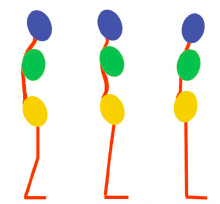The Warrior Way to be powerfully Balanced in Body & Centered in Spirit
The Warrior Way to build physical resilience is to focus on body alignment and breath. Simple as these activities may sound, many adults living in western cultures today, have lost the ability to move with integrated efficiency.
Like the “obesity epidemic” caused by poor dietary habits, Australians are also suffering from chronic injuries and pain due to poor movement habits. Estimates from the National Health Survey (Australian Bureau of Statistics 2007/08) suggest that about 1.8 million Australians or 9.2% of the population suffer from back problems alone.
“Stand like a tree, sit like a rock.
Billow like the Great Waves.”
We practice the Warrior Way of how to stand, how to walk and how to breathe. Our emphasis is on:
Alignment
Establishing the body’s natural alignment through the skeletal system brings people back to a point of “learned” stability so that they know how to achieve physical centredness.
Breathe
Awareness of breath through the use of deep abdominal breathing utilising the diaphragm, allows for integration of our sympathetic and parasympathetic nervous systems.
Connected Movement
Learn to sit by settling the body without slumping or excessive rigidity, stand by erecting ourselves and walk by translating energy into coordinated and balanced momentum over the feet.
“The root is in the feet,
It issues up through the legs,
is directed by the waist,
and expressed through the fingers.”
Stick swinging
When we appreciate that our spine is not just to hold us up but also to connect the pelvis to the shoulders we can appreciate the transmission of energetic flow through the body from feet to fingers.
We practice the Warrior Way of lifting the arms in the motion a sword. Utilising a small massage stick for this exercise helps to coordinate the left and right brain functions with the breath. To raise and lower the arm without disturbing our centre, losing balance or increasing tension in the shoulders or back we need to release and lower the shoulders and let the arm float up whilst putting energy into the little finger.
The use of a small stick provides a number of benefits for todays office workers for whom shoulder tension is a common situation usually related to poor posture, inefficient movement and tension holding patterns. A slouched or an arched posture impedes shoulder function and breathing patterns, which put strain on the spine, whereas a collapsed upper spine with the head and neck forward reduces shoulder flexibility.



